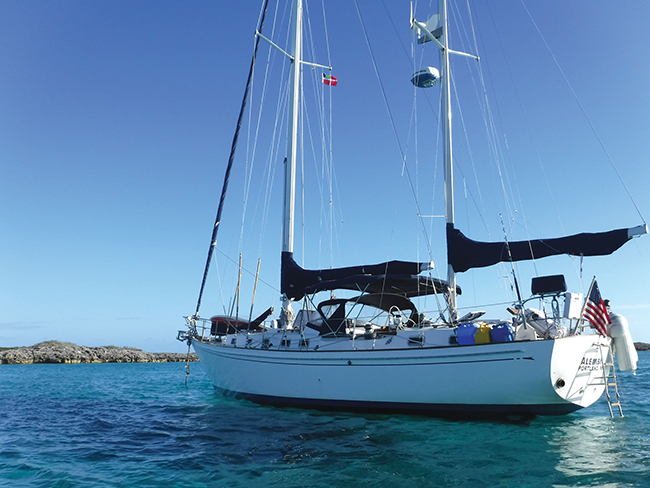For a change of pace, spend a winter cruising from Florida to the Western Caribbean and back. Here’s how (published May 2018)
For U.S. east coast cruisers looking to extend their cruising experience beyond the Bahamas, a Western Caribbean cruise offers an adventurous alternative to the more common Eastern Caribbean destinations such as the BVI and Windward Islands. My favorite Western Caribbean route includes the Bahamas, Cayman Islands, Honduran Bay Islands, Belize and Mexico.
For those with a bit more time, Cuba and Jamaica are also convenient to this route. One of the greatest aspects of this itinerary is that most of this sailing route takes advantage of favorable winds and currents. This is a key difference between this Western Caribbean route via the “Thornless Path” of traveling upwind from the Bahamas to the BVI via Turks and Cacaos, Dominican Republic, and Puerto Rico. That can be a real slog.
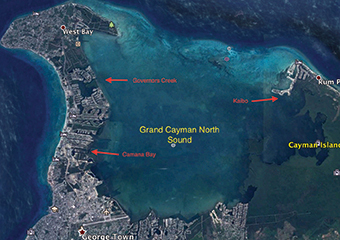 DEPARTING THE BAHAMAS
DEPARTING THE BAHAMAS
Georgetown, Bahamas, with its proximity to the Windward Passage, offers a good starting point for the Western Caribbean. Skipper and crew wait for a period of light winds from the northeast and steer a course directly for the western end of Great Inagua Island. Exiting Georgetown via Hog Key Cut to the southeast of Georgetown is a neat little adventure. Vessels with six feet of draft or less can use this short cut.
Alternatively, you may sail around the north end of Long Island and then steer southeast to the same waypoint at the Western End of Great Inagua. We did not make landfall on Great Inagua but used this as a waypoint before steering toward the Windward Passage just east of Cuba. We know boats that have stopped at Matthew Town on Great Inagua. It is possible to clear out with Bahamas customs and immigration at Matthew Town.
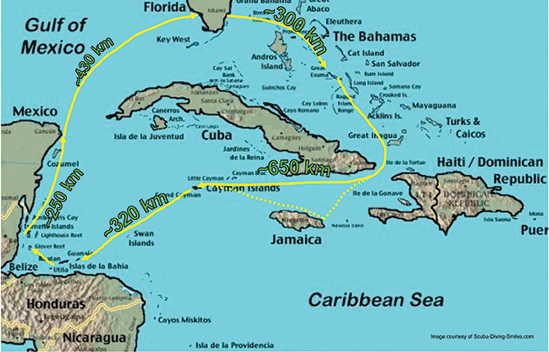 Once you have cleared the southeast corner of Cuba, the passage to Grand Cayman is an easy downwind run in the prevailing trade winds. For much of this leg of the trip, you glide along the south coast of Cuba approximately five to 10 miles offshore. If someone wanted to enjoy a stop in Cuba, Santiago, Cuba is an official point of entry and an easy diversion from the rhumb line to Grand Cayman.
Once you have cleared the southeast corner of Cuba, the passage to Grand Cayman is an easy downwind run in the prevailing trade winds. For much of this leg of the trip, you glide along the south coast of Cuba approximately five to 10 miles offshore. If someone wanted to enjoy a stop in Cuba, Santiago, Cuba is an official point of entry and an easy diversion from the rhumb line to Grand Cayman.
Or, if someone wanted to make a stop in Jamaica, Port Antonio or Montego Bay are just 60 miles south of the course to Cayman Islands. Our passage from Georgetown, Bahamas, directly to George Town, Grand Cayman, took 5 days. For much of the passage we were on a very broad reach or sailing wing and wing. For our passage, the winds were less than 15 knots with seas less than three feet for most of the trip.
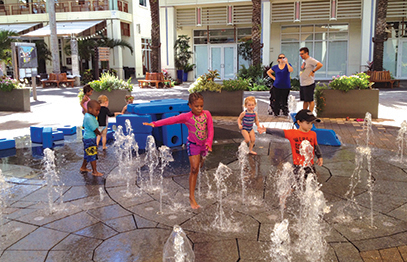 GRAND CAYMAN
GRAND CAYMAN
Grand Cayman is a wonderful island to visit. Although the island has a bustling cruise ship port and numerous resort hotels, it remains quite accommodating to cruisers. Clearing customs is easy at the port of George Town. The offices are located right on the waterfront and an officer will guide you to the different offices – Immigration, Customs, and Port Authority. There are free moorings right at the port of George Town and a secure dinghy dock. A wonderful Kirklands grocery store is walking distance from the dinghy dock.
For boats drawing seven feet or less, North Sound offers settled anchorages and a variety of places to visit. One of the best all-around anchorages is in Governor’s Creek. The entrance is easy and we went in and out several times never seeing less than eight feet of water. We preferred to anchor just inside near the Cayman Islands Yacht Club. From here it is an easy dinghy ride up a canal to the back side of Seven Mile Beach or ashore to the restaurants near the Yacht Club.
We also took a couple of trips with Alembic through the canals to a wonderful quiet basin that is an easy walk to a major discount grocery store. For an experience that is truly unique in the Western Caribbean, we tied up at the Camana Bay Yacht Basin. The cost was less than a mooring on the U.S. east coast. Camana Bay is much like Coconut Grove with shopping, restaurants, a movie theater, and the best gelato in the Caribbean. For a polar opposite experience, we traveled across North Sound to the seclusion of the Kaibo anchorage and enjoyed snorkeling off Rum Point.
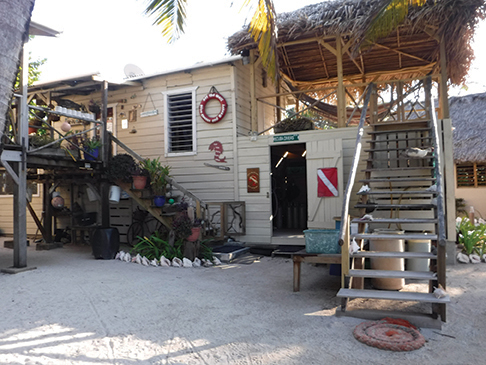 HONDURAS
HONDURAS
After clearing out of the Cayman Islands, you again sail downwind for two and half days and will find yourself off Guanaja, 25 miles northeast of Roatan, Honduras. Guanaja is a great place to start your Bay Island experience and an easy destination to enjoy. A unique aspect of the place is that the majority of the population lives on the small island that sits one mile south of the main island. Over 4,000 people live on this small island in the town of Bonacca. Helpful ambassadors will meet you at the dinghy dock and guide you through the immigration and customs process. Fees are minimal and the authorities are helpful and pleasant. The ambassadors are happy to receive a $10 tip for their services.
After clearing in, enjoying a cold beer in one of the small bars, shopping, and exploring the busy small town of Bonacca you will want to move over to El Bight Bay to anchor among the other cruisers and enjoy this tranquil setting. Ashore there is a delightful walk to several different restaurants as well as an adventurous hike to the peak of the island. A short dinghy ride from the anchorage are wonderful reefs for snorkeling and fishing.
Roatan is an easy daysail downwind from Guanaja. The Frenchman’s Cay area offers both an excellent anchorage behind the reef as well as a welcoming marina. From here it is an easy walk or short cab ride to a modern grocery store for provisioning. It is also an easy place to arrange transportation to other areas of the island.
Roatan can be a bit hectic. After a short visit here, the mellow vibe of Utila is a short daysail farther west. Utila has a wonderful anchorage right off the main village, which is an eclectic destination for divers and young travelers. It is an excellent place to find whale sharks during the season and several reefs are a short dinghy ride from the anchorage. Restaurants are inexpensive and it is a handy place to provision especially for beer and wine before traveling to Belize. Don’t miss the authentic French crepes from the small creperie on Main Street. Clearing out of immigration and customs is also very easy to complete in Utila.
BELIZE
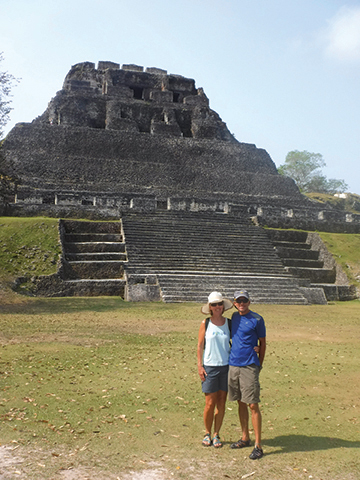 From Utila, the offshore Belizean atoll of Glover’s Reef is just 60 miles to the northwest. We chose to leave Utila at about 2200 hours in the evening and sail overnight so we could arrive at Glover’s Reef in the morning with the sun high enough to navigate through the entrance to the atoll. Leaving the anchorage at Utila in the dark can be a bit dodgy. If you save an incoming track on your chartplotter, following this track on departure can give you some peace of mind.
From Utila, the offshore Belizean atoll of Glover’s Reef is just 60 miles to the northwest. We chose to leave Utila at about 2200 hours in the evening and sail overnight so we could arrive at Glover’s Reef in the morning with the sun high enough to navigate through the entrance to the atoll. Leaving the anchorage at Utila in the dark can be a bit dodgy. If you save an incoming track on your chartplotter, following this track on departure can give you some peace of mind.
The channel into Glover’s Reef is easily followed in good light. The entrance on the south end of the atoll is wide and calm and a wonderful anchorage lies just inside this southern entrance through the reef. This anchorage offers a delightful sense of all Belize cruising has to offer. The reefs are healthy and are teaming with fish of many species. Spear fishing is allowed on the southern edge of the reef, while the reefs in the conservation zone offer spectacular viewing.
From Glover’s it is best to sail directly to Placentia to complete the clearance process. Clearing into Belize at Placentia is actually an enjoyable adventure. Captain and crew pack up the ship’s papers and passports and walk through town to the Hokey Pokey water taxi to Mango Creek. Upon landing at Mango Creek, hop into any taxi and the driver will transport and direct you through the different offices you need to visit in Big Creek including: Immigration, Agriculture, Port Officer, and Customs. Although, there may be a short wait at one or two of these stops, the officials are always courteous and friendly.
While you are in Mango Creek, ask the taxi driver to take you to one of the local restaurants for breakfast or lunch. The last time I cleared into Belize, I took the first boat in the morning from Placentia and had time for breakfast before the immigration office opened. I had a wonderful breakfast in a small local place. Eggs fresh from the chicken coop out back and fried jack, a Belizean specialty.
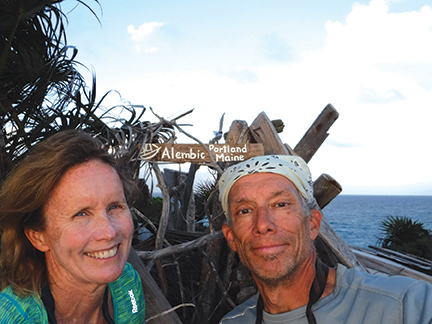 After completing clearance and provisioning in Placentia, you are off to the many cays along the barrier reef that runs the length of Belize. In total, we have spent over 10 weeks cruising Belize and there are still numerous cays and anchorages that we have not explored! If necessary, you can easily cruise from Placentia to Belize City in one week with a short sail each day and a fresh anchorage each night.
After completing clearance and provisioning in Placentia, you are off to the many cays along the barrier reef that runs the length of Belize. In total, we have spent over 10 weeks cruising Belize and there are still numerous cays and anchorages that we have not explored! If necessary, you can easily cruise from Placentia to Belize City in one week with a short sail each day and a fresh anchorage each night.
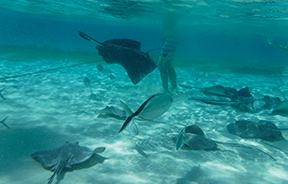 We find Belize is a wonderful place to host guests. You can either meet them in Placentia or Belize City and share a wonderful week of unique sailing, snorkeling, and dining. We have spent time in the BVI as well as Belize. Our experience is that Belize tops the BVI as a destination for sailing in sheltered waters surrounded by amazing reefs and other natural wonders. There are also plenty of beach bars to enjoy sundowners or an occasional meal ashore.
We find Belize is a wonderful place to host guests. You can either meet them in Placentia or Belize City and share a wonderful week of unique sailing, snorkeling, and dining. We have spent time in the BVI as well as Belize. Our experience is that Belize tops the BVI as a destination for sailing in sheltered waters surrounded by amazing reefs and other natural wonders. There are also plenty of beach bars to enjoy sundowners or an occasional meal ashore.
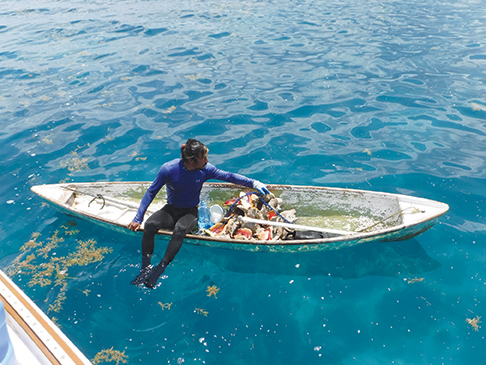 HOMEWARD BOUND
HOMEWARD BOUND
Once your time in Belize comes to an end, it is time to start heading north to Mexico or the U.S.A. As for Mexico, El Cid Marina in Puerto Morelos or Isla Mujeres are both an easy overnight sail. Once you near Cozumel, the favorable Yucatan current kicks in at nearly two knots. With prevailing easterlies trade winds, this sail is typically an exhilarating close reach. Mexico offers a great place to breakup the trip back to the USA. Clearing in and out, however, can be a bit tedious. Our experience is that it is worth using an agent. They are well worth the $50 cost for this service.
Whether leaving directly from Belize or from Mexico, the trip back to Florida will be the toughest part of the overall trip. With the right weather, heading straight to Key West or the Dry Tortugas is the preferred route. One year we made the trip from Belize City to the Dry Tortugas in just over 72 hours traveling just south of a front that pushed out the prevailing easterly trades. Another year, we left Isla Mujeres and sailed for southwest Florida closehauled in settled easterlies. We made our landfall in Fort Myers after three and a half days on a single tack. Both of these passages were good for building our experience with sailing close to the wind and managing currents that flowed in variable directions along the passage.
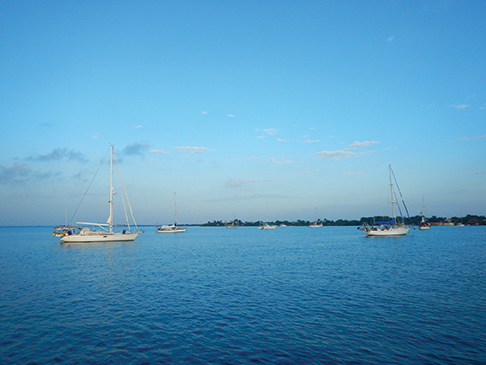 Your return to U.S.A. will close the loop of your western Caribbean cruise. You will have visited a number of new cruising destinations that will expand your horizons beyond the more commonly cruised waters of the Bahamas and Lesser Antilles. You will also have logged over 2,000 nautical miles and built your confidence and experience for other cruising adventures.
Your return to U.S.A. will close the loop of your western Caribbean cruise. You will have visited a number of new cruising destinations that will expand your horizons beyond the more commonly cruised waters of the Bahamas and Lesser Antilles. You will also have logged over 2,000 nautical miles and built your confidence and experience for other cruising adventures.
Bill Weigel and his wife Helen have been full time cruisers since 2015. They have spent two winters in the western Caribbean sailing back to Maine each summer. This summer they plan an Atlantic crossing on their Whitby 42 ketch Alembic.

















